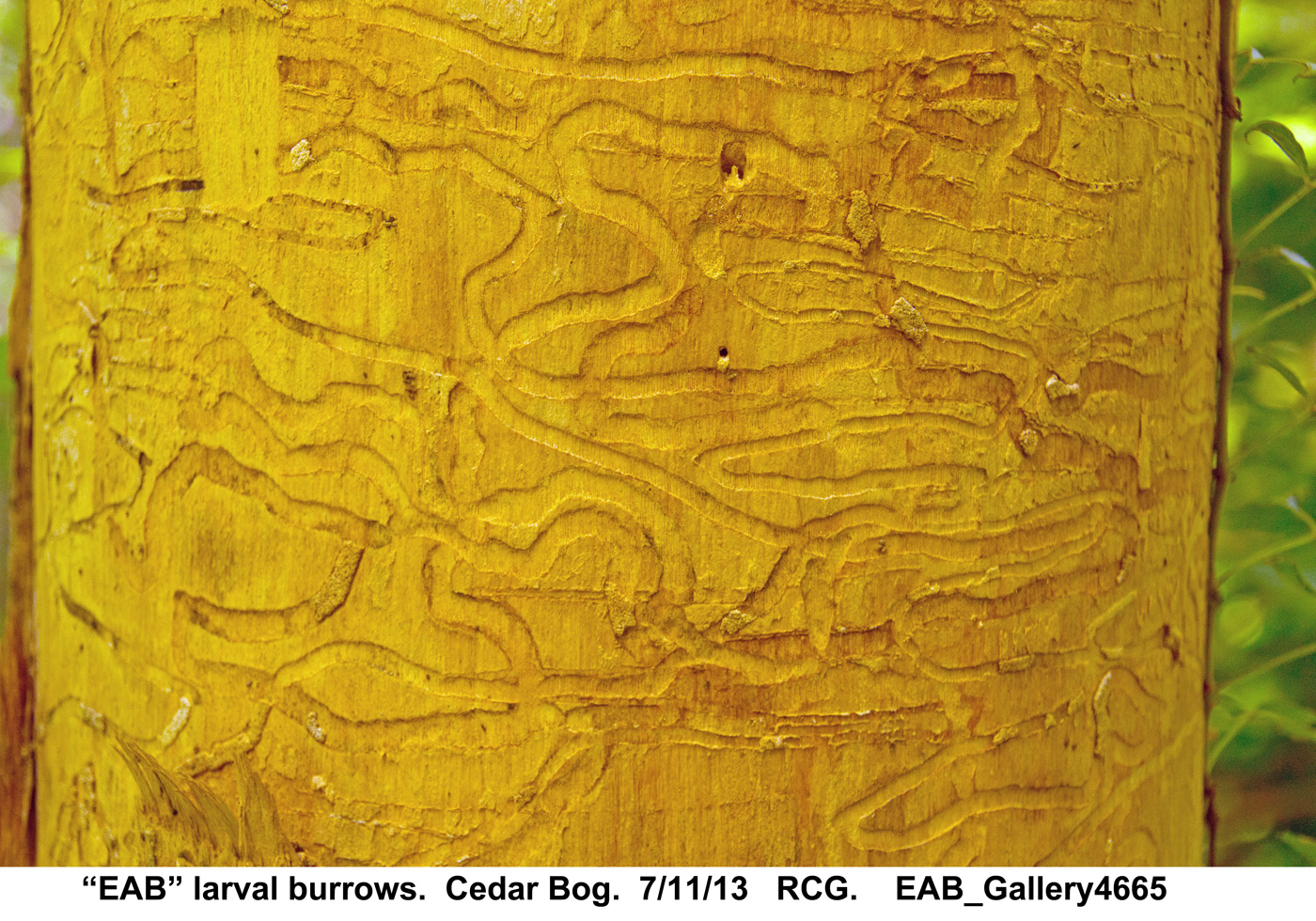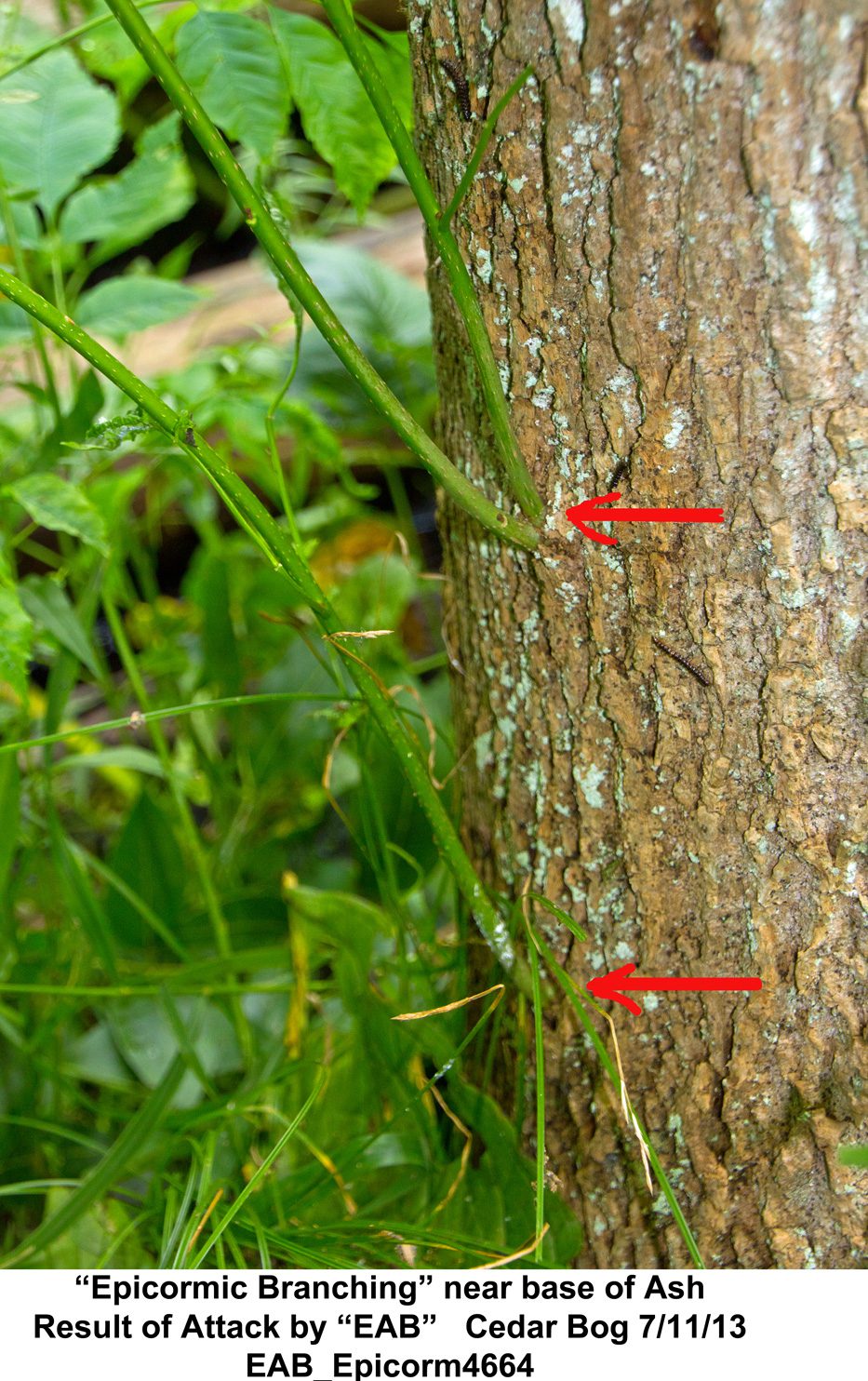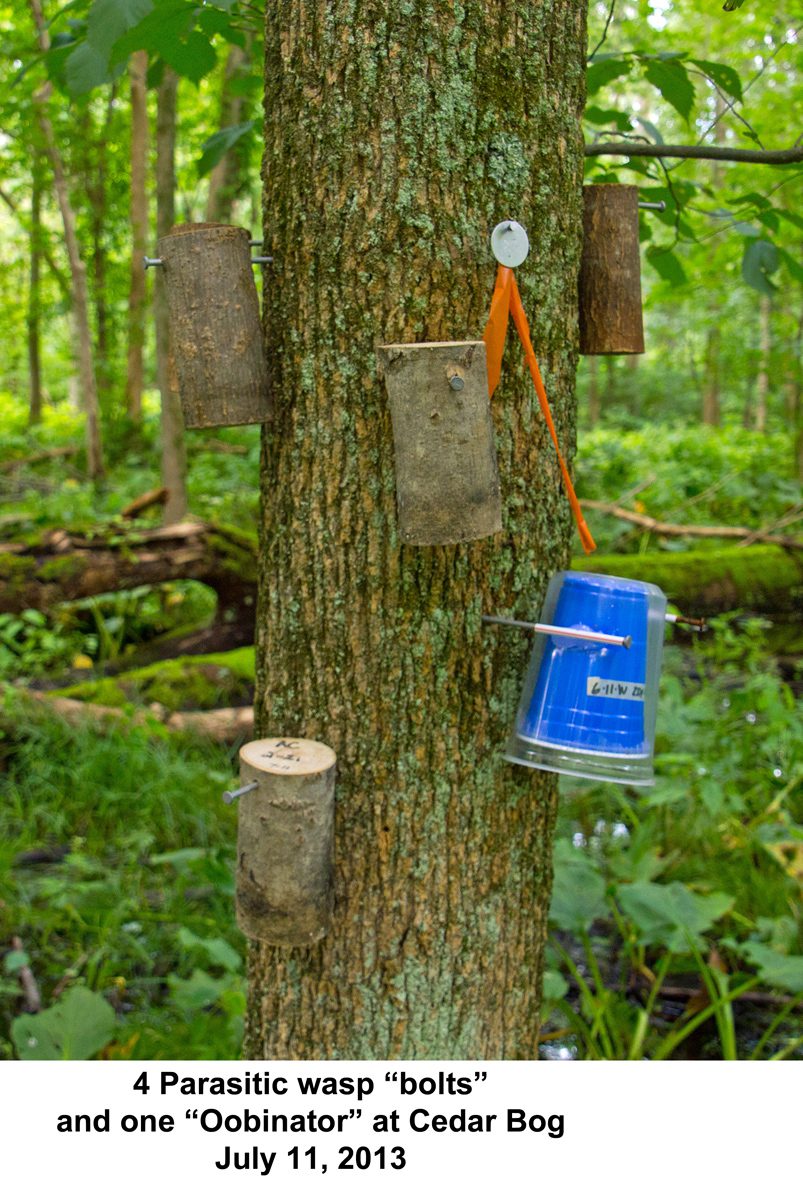On May 29th of last year I posted a blog about our efforts to introduce parasitic wasps at Cedar Bog to combat the exotic, invasive beetle known as the Emerald Ash Borer (abbreviated EAB). This insect, carelessly introduced on untreated wooden pallets from Southeast Asia, has destroyed millions of ash trees in at least 17 states plus the Canadian province of Ontario. It is specific to ash trees and attacks and kills all species of ash. Without any intervention, 95 percent of the ash trees will be dead within three to five years. Some die even faster.
Ash trees make up 12 to 15 percent of Ohio’s forests in general, but the Swamp Woods at Cedar Bog have ash concentrations as high as 60 to 80 percent in the wettest areas where Black Ash dominates. Ash trees are also important trees in urban landscaping, and White Ash is still the preferred wood for baseball bats–but is used for many other products as well. Of course, in the natural landscape, numerous native species of insects, birds and mammals use ash–some depending upon ash for food or shelter. You may wish to review in more detail the start-up of our efforts at Cedar Bog to attack the EAB and you can find that link here.
During the summer and early fall of 2012 we made 11 different introductions of the three species of parasitic wasps, totaling a release of more than 18,000 wasps. This was much more aggressive than releases at other sites in previous years. Some sites in previous years introduced as few as 200 of each of the three species in one single event. Our relatively aggressive efforts last year reflects in part on our own desire to ramp up the effort at Cedar Bog, in part the recognition by the USDA that all sites needed a more aggressive approach and in part due to the increased production of the parasitic wasps by the USDA labs making more wasps available.
Introducing 18,000 parasitic wasps sounds like a massive attack on the EAB. Imagine introducing 18,000 wolves into central Ohio to control the deer population! Obviously this comparison seems a bit extreme. But we don’t have a good handle on how many Emerald Ash Borers are in the swamp woods at Cedar Bog, and how many wasps would it really take to impact them? Looking at EAB galleries in a single ash shows us they have huge populations in each and every infected ash tree. But how many EAB are at Cedar Bog, and how many parasitic wasps are enough to impact the EAB population? Furthermore, how many wasps that are released survive long enough to parasitize the EAB? Do they stay alive in their overnight shipment, only to die shortly after release, or do they thrive and actively attack the EAB? This entire process is still new enough that I don’t have good answers to those questions.
So in April of 2013 Avi Eitam from the USDA labs in Reynoldsburg, Ohio and I headed out to Cedar Bog where our new Site Manager, Tracy Bleim, joined us as we tried to see if we could find any evidence of wasp survival over the winter. The idea was to peel bark from some dying trees and look for EAB larvae that were infested with parasites. We selected three different trees, each either well under attack from EAB, or perhaps already recently dead. We peeled bark and found lots of EAB galleries or burrows beneath the bark. 
Neither Avi nor I had done this before, but we knew how to find EAB larvae–at least in mid-summer. Apparently they are much harder to find in late winter. We saw lots of sign of activity, but not a single EAB larva, let alone larvae that were infested with parasites. [I did bring several pieces of bark back to my lab and placed them in a rearing chamber. From about two square feet of bark, a month later I collected eight adult EAB. Apparently the larval EAB must migrate up into the bark just before emergence as adults, and we had only looked beneath the bark.]
Looking around, we were convinced that EAB were alive and well at Cedar Bog. We saw several trees that were clearly dying. While these numbers were still small compared to the total number of ash trees at the site, there were many more dead or dying trees than we could see early last fall. While much of the larval feeding takes place while it’s warm, the effects on the tree seem to become much more apparent the following late winter to early spring. We could find lots evidence of woodpecker activity on dead and dying trees. Shredded bark showed where the woodpeckers had been attracted to concentrations of EAB which they are attracted to for food. It is too bad that the woodpeckers cannot keep ahead of the ash destruction! We also saw an increase in living ash trees of what is called epicormic branching.

These are small sprouts on the trunk of the tree, often close to eye level although sometimes higher up. The epicormic branching is part of the trees natural defense against loss of live branches higher in the tree sending out new, lower branches that can still communicate through the xylem and phloem under the bark with the roots. New branches and leaves at such levels could keep the bottom of the tree alive if the EAB did not continue to move downward and infest the whole tree which is what eventually happens.
So, the EAB were still active based on epicormic branching, woodpecker damage and a number of dead trees. We were a little discouraged that we could not find evidence of adult parasitic wasps, or EAB larvae infested with parasites. Were our efforts last summer totally lost? As we looked around, we decided that there was circumstantial evidence that the wasps were working although perhaps not as well as we had hoped. As we looked at dead trees, they seemed to be more prevalent further from the core area of our wasp release, and much less prevalent around the release sites. So perhaps we were at least slowing the EAB down within our core release area.
Meanwhile, the USDA staff which preforms the rearing of the parasitic wasps in Brighton, Michigan, led by Jon Lelito, had been evaluating their rearing processes and trying to make them more labor efficient. They came up with a plan to ship us not live, adult parasitic wasps, but small bolts of ash trees (roughly six inches long by 2.5 inches in diameter) that had within them EAB larvae with the wasp parasites inside of them.

These bolts were shipped to us in insulated chests by overnight delivery just as the plastic containers of live adults had been the previous year. The parasites within the EAB larvae in the bolts would react much less to the stress of shipping than live adults might at least that was the assumption. As the bolts sat in the natural environment (nailed to our test trees), the local weather conditions and gradual maturation of the parasitic larvae would eventually result in both dead EAB larvae and emergence of adult parasitic wasps on our site. They would emerge fresh and ready to seek and destroy EAB larvae. Since this also saved time and effort for the staff at the Brighton labs, they could send us greater and more frequent shipments of parasitic wasps.
So this year we are releasing wasps almost once a week. Since we started with our first release on May 16, 2013 we have had eight releases as of July 24th. This has totaled 27,855 wasp larvae. Most of these have been in bolts, with a number of the egg parasites (Oobius agrili) in “Oobinators” on EAB eggs, and a few containers of mature adults that had emerged in the Brighton labs. Tentatively we have scheduled releases for every week in August and several into September–potentially eight additional releases. If numbers remain available, that could mean the release of more than 55,000 parasites or three times the volume released last year, or more than 90 times those released several years ago at several sites in the first experimental releases. Meanwhile, well be watching the condition of the ash at Cedar Bog and likely will do some more bark peeling on trees nearly dead to see if we can find parasites in EAB larvae.
Wish us success! No, change that. Wish success for our ash trees and the swamp woods habitat at Cedar Bog!
Bob Glotzhober
Senior Curator of Natural History